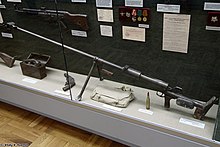PTRD-41
| PTRD-41 | |
|---|---|
Degtyaryov plant | |
| Produced | 1941–1945 |
| No. built | ~450,000[6] |
| Specifications | |
| Mass | 17.3 kg (38.1 lbs) |
| Length | 2,020 mm (79.5 in) |
| Barrel length | 1,350 mm (53 in) |
| Crew | 2 |
| Cartridge | 14.5×114mm (B-32, BS-41[7]) |
| Action | Bolt-action |
| Rate of fire | Manual |
| Muzzle velocity | 1,012 m/s (3,320 ft/s) |
| Effective firing range | 300 m (980 ft) (on personnel targets, dispersion of bullets at 300 m (980 ft) is 0.36 m (1 ft 2 in)[7]) |
| Maximum firing range | 1,000 m (3,300 ft)[7] (mainly with scope) |
| Feed system | Single-shot |
| Sights | Front post, rear notch |
The PTRD-41 (Shortened from Russian, ProtivoTankovoye Ruzhyo Degtyaryova; Противотанковое однозарядное ружьё системы Дегтярёва образца 1941 года; "Degtyaryov Single Shot Anti-Tank Weapon System Model of 1941") is an
self-propelled guns and half-tracks
.
History

In 1939, in its invasion of Poland the USSR captured several hundred Polish
Panzerbüchse 38 when hasty construction of an anti-tank rifle was ordered in July 1941.[citation needed
]
The PTRD and the similar but
anti-tank weapons available to the Red Army in numbers upon the outbreak of the war with Germany. The 14.5 mm armor-piercing bullet had a muzzle velocity of 1,012 m/s (3,320 ft/s). The 64 g (2.3 oz) bullet had a 39 g (1.4 oz) steel core and could penetrate around 30 mm (1.2 in) of armor at 500 m (1,600 ft), and 40 mm (1.6 in) of armor at 100 m (330 ft).[10] During the initial invasion, and indeed throughout the war, most German tanks had side armor thinner than 40 mm (1.6 in) (Panzer I and Panzer II: 13–20 mm (0.51–0.79 in), Panzer III and Panzer IV series: 30 mm (1.2 in), Panzer V Panther
(combat debut mid-1943): 40–50 mm (1.6–2.0 in)).
Guns captured by the Germans were given the designation 14.5 mm PzB 783(r).[11] After World War II the PTRD was also used extensively by
Chinese armed forces in the Korean War. During this war, William Brophy, a US Army Ordnance officer, mounted a .50 BMG (12.7 mm) barrel to a captured PTRD to examine the effectiveness of long-range shooting. Furthermore, the US also captured a number of PTRDs in the Vietnam War. The weapon proved effective out to 1,800 m (5,900 ft).[12]
Users
This section needs additional citations for verification. (March 2019) |
Current


 Donetsk People's Republic: Used by militiamen in 2014.[13]
Donetsk People's Republic: Used by militiamen in 2014.[13] Russia: Limited use in the Syrian civil war[14]
Russia: Limited use in the Syrian civil war[14] Ukraine: Limited use in the war in Donbas[14]
Ukraine: Limited use in the war in Donbas[14]
Former
 Bulgaria: Equipped with 300 items (both PTRD & PTRS) by Soviet Union between 1944 and 1945, seen in combat operations.
Bulgaria: Equipped with 300 items (both PTRD & PTRS) by Soviet Union between 1944 and 1945, seen in combat operations. China: Used in Chinese Civil War, later by People's Volunteer Army during Korean War.
China: Used in Chinese Civil War, later by People's Volunteer Army during Korean War. Czechoslovakia: Used by 1st Czechoslovak Army Corps in the USSR.
Czechoslovakia: Used by 1st Czechoslovak Army Corps in the USSR. Nazi Germany: Captured and used by Wehrmacht under the title Panzerbüchse 783(r).[11]
Nazi Germany: Captured and used by Wehrmacht under the title Panzerbüchse 783(r).[11] North Korea: Equipped by the USSR, saw extensive combat in Korean War against M24 light tanks.[15]
North Korea: Equipped by the USSR, saw extensive combat in Korean War against M24 light tanks.[15] Poland: Used by 1st Tadeusz Kościuszko Infantry Division in 1943 then by other Polish divisions.
Poland: Used by 1st Tadeusz Kościuszko Infantry Division in 1943 then by other Polish divisions. North Vietnam: In stockpile, used by Viet Cong in Vietnam War.[1]
North Vietnam: In stockpile, used by Viet Cong in Vietnam War.[1] Soviet Union: Largely used in Eastern Front by the Red Army.[15]
Soviet Union: Largely used in Eastern Front by the Red Army.[15]
See also
- List of Russian weaponry
- PTRS-41
References
- ^ a b "WWII German weapons during the Vietnam War". wordpress.com. 10 July 2015. Retrieved 8 December 2017./
- ^ "- YouTube". YouTube.
- ^ "PTRD in Ukraine". 5 October 2014.
- ^ "PTRS-41 and PTRD-41 rifles in action at the conflict in Ukraine". 13 October 2014.
- ^ Sneider, Noah (24 July 2014). "Huddling with Ukrainian Rebels in a Bunker on the Front Lines". The New Republic.
- ISBN 9780275948931.
- ^ a b c Manual on Small Arms (NSD-42) Military Publishing House Moscow 1942
- ^ "Karabin przeciwpancerny wz. 35". 10 June 2020.
- ^ "Karabin przeciwpancerny wz. 35 "Ur"". YouTube.
- ^ "Page 6: Tank Rifles", Panzerfaust: WW II German Infantry Anti-Tank Weapons, 1998, archived from the original on 27 October 2009
- ^ OCLC 1299755.
- ^ "Hard Target Interdiction" (PDF). www.remingtonmilitary.com/. Remington Arms. 2005. Archived from the original (PDF) on 20 March 2006. Retrieved 13 December 2008.
- ISBN 9780992462437.
- ^ a b "The Sniper Weapon Systems of Russian Forces in Syria". The Hoplite. Armament Research Services (ARES). 6 August 2016. Retrieved 25 April 2024.
- ^ a b "Warfare History Network » WWII Weapons: The PTRS and PTRD Russian Anti-Tank Rifles". warfarehistorynetwork.com. Archived from the original on 14 January 2017.
- Koll, Christian (2009). Soviet Cannon - A Comprehensive Study of Soviet Arms and Ammunition in Calibres 12.7 mm to 57 mm. Austria: Koll. p. 91. ISBN 978-3-200-01445-9.
External links
Wikimedia Commons has media related to PTRD-41.
